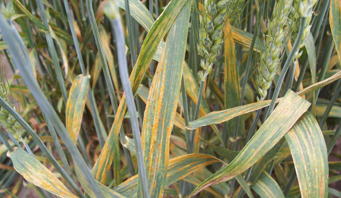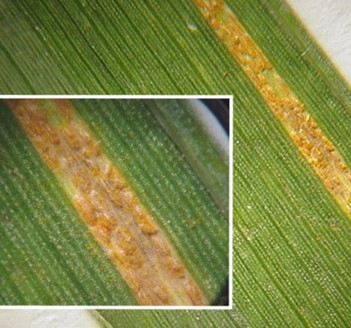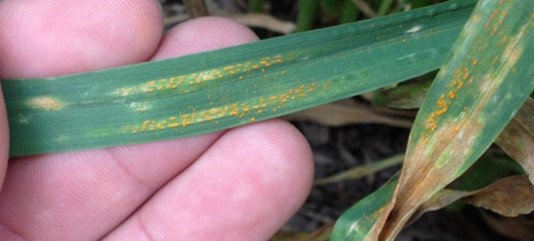Pathogen Facts
- Stripe rust, also called yellow rust, is caused by the fungal pathogen Puccinia striiformis.
- This disease can be distinguished from stem and leaf rust by the formation of the pustules and the coloration of the urediniospores.
- This pathogen is common in areas with higher elevations due to the cooler climate with frequent leaf wetness.

Puccinia striiformis infection of wheat. Photo courtesy of Sam Tragesser, Senior Research Associate.
Symptoms and Signs
- Initial symptoms are circular to oval yellow spots on upper leaf surfaces at the infection sites.
- These develop into yellow-orange pustules bearing urediniospores that dust off when disturbed.
- Lesions elongate, forming a notable stripe shape on leaf surfaces.
- Photosynthesis is reduced as functional leaf area decreases, which can reduce head fill and yield.
- Darker colored teliospores form later in the season.

Urediniospores from Puccinia striiformis. Photo courtesy of Matt Montgomery, Field Agronomist

Stripe rust pustules forming elongated lesions. Photo courtesy of Craig Herzog, Senior Agronomist
Conditions Favoring Disease
- Stripe rust can develop at lower temperatures than other rust diseases. Development is favored by 50-64 °F (0-18 °C) temperatures with at least six hours of dew present.
- Stripe rust can survive winter temperatures above 23°F (-5°C).
- Urediniospores can travel long distances, spreading from field to field via wind.
Management Considerations
- Planting resistant wheat varieties is the primary method to reduce losses to stripe rust.
- There are two types of genetic resistance to stripe rust: seedling resistance and adult plant resistance.
- Seedling resistance is effective throughout the life of the plant, but is usually only against some races of the pathogen
- Adult plant resistance develops as plants mature.
- If growing a susceptible variety, and infection occurs on the flag leaf, then foliar fungicide application may be justified.
- Decreasing irrigation in fields also limits the amount of water available for leaf wetness, disfavoring disease development.
References
CAHNRS & WSU Extension. (n.d.). Wheat & Small Grains. Retrieved from Washington State University College of Agriculture, Human, and Natural Resource Sciences: http://smallgrains.wsu.edu/disease-resources/foliar-fungal-diseases/stripe-rust/
Martinez, A., Youmans, J., & Buck, J. 2009. Stripe Rust (Yellow Rust) of Wheat. Retrieved from University of Georgia Extension: https://extension.uga.edu/ publications/detail.html?number=C960&title=Stripe%20Rust%20(Yellow%20Rust)%20of%20Wheat
Author: Madeline Henrickson
The foregoing is provided for informational use only. Please contact your Pioneer sales professional for information and suggestions specific to your operation. Product performance is variable and depends on many factors such as moisture and heat stress, soil type, management practices and environmental stress as well as disease and pest pressures. Individual results may vary.
Vol. 12 No. 15 May 2020








